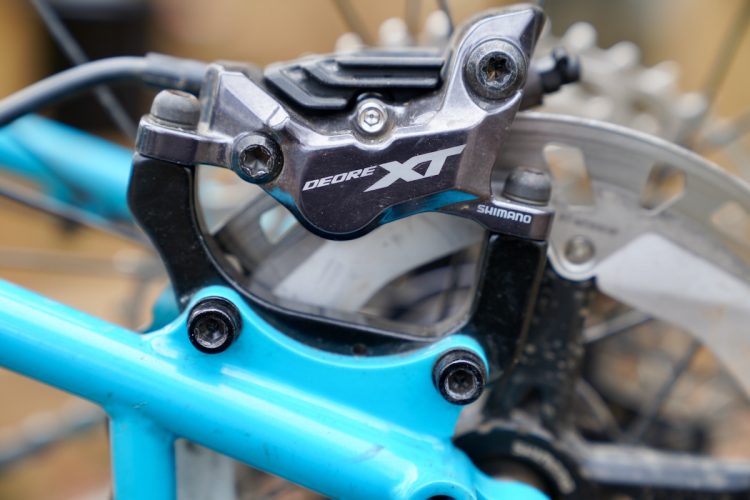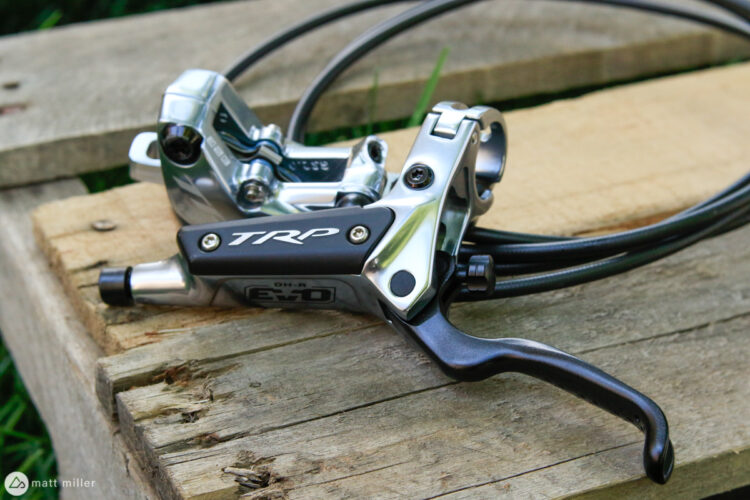
Shimano MT520 Brakes
- Price: $74 Front / $138 Rear
- Buy from Amazon
Developed for the rapidly expanding eMTB market, the BR-MT520 is Shimano’s latest 4-piston brake offering. Despite the design brief, this brake is also perfect for the budget enduro market, and will be coming specced on lots of entry level 2019 enduro bikes, including the Giant Reign 2 for example. The Shimano MT520 is technically a non-series Shimano component, though it’s essentially the Deore equivalent of their XT 4-piston brakes.
Part of what makes lower price level Shimano component groups so great is that they tend to trickle their technology down from their higher-end parts. This means that they compromise slightly on things like aesthetics, weight, and adjustability, but still retain their legendary performance and reliability. This creates great components that are affordable by us mere mortals. The new Shimano MT520 brake set is no different. For your money, you get ceramic pistons, the Shimano MT501 lever with servo-wave and I-spec II compatibility, and the monster 4-piston caliper.
The Shimano MT520 caliper is their only 4-piston caliper that doesn’t look identical to the others in their range (Saint, Zee, XT). You could even say that it looks a little sleeker, however it does use the same (non-finned) pads. It comes stock with the D01 resin pads, but you can easily upgrade to their metal pads once you’re due a pad change, adding some extra power and life. Couple this with one of their RT86 Icetech rotors as I have done, and you’ve got a killer brake set at a pretty affordable price. It’s worth noting that the Icetech-finned pads do not fit unless you trim the fins a little with a rotary tool.

In terms of fitting and setup, these are as easy as any other Shimano brake. The levers have a split clamp, so no need to remove your grips and/or shifters to fit them. The calipers mount easily, and centered up for me on the first attempt – which is not always the case with 4-pot brakes. With regard to bleeding, they bleed just as easily as any other Shimano brake on the market.
The lever feel is good. They have slightly more free-stroke than Shimano Saint brakes and Zees, but have no free stroke adjustment. The Shimano MT520 brakes have a solid bite point, though as with all Shimano brakes, this means less modulation than other brakes. I find that this is personal preference however, and I personally have no problem applying the right amount of power for the situation. You just learn to use a lighter touch than with other mountain bike brakes.
The lever blade is also the same as other Shimano brakes — I find that they fit the shape of my hand nicely and I like the short blade, though it’s not to everyone’s tastes.

There are a few drawbacks to these brakes when you compare to their more expensive siblings in the Shimano range.
As mentioned earlier, the levers lack a free-stroke adjust, and the reach adjust is not tool-free. The lever blades lack the dimpled texture of the better brakes. The callipers don’t work with finned pads without modifying the pads. The pads are fitted using a split pin, rather than a threaded bolt. The hose connects to the calliper via an in-line connector rather than a banjo, so you can’t adjust the hose angle/routing quite as nicely. Aesthetically speaking, they are fairly bland and basic.
Having said all of this, none of these things actually affect the operation of the brakes. Once you’re hammering down the trail they just work, and they work well. It’s also fair to assume that there is a weight penalty, but Shimano doesn’t provide a claimed weight for these or their XT 4-piston brakes. I can say they don’t feel noticeably heavy. If you’re a gram counter, these brakes probably aren’t on your radar anyway.

In the real world, the Shimano MT520 brake is a remarkably powerful brake for the money, and makes a great upgrade to the stock SRAM Guide R brakes on my bike. I have no trouble locking up a big grippy tire when I want to, and I find I have less arm pump when attacking steep, rough, sustained descents, with plenty of power on tap.
A 203/180mm combo works great on my trail bike, and in truth I could probably get away with a 180mm on the front. With all of Shimano’s tech aiming at reducing heat build-up, such as ceramic pistons, larger braking surface etc., the MT520 should be quite difficult to overheat. Based on my testing, this certainly holds true.
For no-frills performance in the budget-conscious trail/enduro/downhill/eMTB market, these brakes, retailing for around $100 per wheel, are an absolute no-brainer for the money. Honestly, I’ve yet to use anything better in this price bracket.
- Price: $74 Front / $138 Rear
- Available from Amazon and other online retailers



















